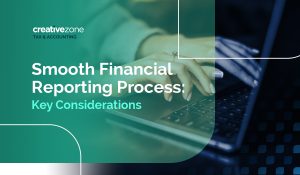
The year’s end is the most critical time for an accounting professional. Why is it so? This is because it is the time to produce financial statements for the entire year. The three most common financial statements are the balance sheet, income statement, and cash flow statement. The process of year-end closing is not simple. Finance professionals need to work long hours in order to review and reconcile the books of accounts. Every business needs a smooth financial reporting process in order to save time and avoid stress.
What is a Year-End Closing?
In simpler terms, a year-end closing is a process of finalizing a company’s accounts at the end of the financial year. It is also known as closing the books. Year-end closing involves several accounting activities and procedures in order to ensure that financial records are complete and accurate. It allows companies to prepare for a potential external audit, prepare tax filings, make informed decisions, and boost investor confidence. The closing of books process usually involves the following steps:
- Account Reconciliations: The first step is to perform account reconciliations. This ensures that every transaction is recorded. For instance, most businesses reconcile bank accounts, accounts receivable, and accounts payable. Reconciling these accounts involves comparing a business’s records with those of external sources to identify discrepancies.
- Adjusting Entries: The next step is to perform adjustments and also correct errors. The most common adjusting entries are for accruals and prepayments.
- Closing entries: As part of the closing process, accountants close temporary accounts by transferring their balances to permanent accounts. For instance, revenue and expense accounts are temporary; their balances are transferred to the retained earnings account, which is a permanent account.
- Financial Statements: Finally, financial statements are produced as per generally accepted accounting principles. An audit is then conducted to ensure that financial statements are free from material errors and comply with the relevant laws and accounting standards.
Key Considerations for a Smooth Financial Reporting Process
The process of year-end reporting might be hectic and time-consuming. However, a properly planned closing process and a proactive approach can lead to a smooth reporting process. Here are some of the key considerations to ensure a smooth year-end financial reporting process:
Plan financial reporting process:
Planning ahead for the closing of books is one of the key considerations for any type of business. This involves scheduling all the key tasks, including reporting dates and assigning duties. Based on this information, delegate responsibilities to the relevant team members. This avoids any kind of confusion in the reporting process, ensuring a smooth close.
Review and verify on a regular basis:
To ensure accuracy, experts advise regularly reviewing and confirming financial data, such as weekly or monthly. The key is to avoid panic at the year’s end. Even if an organization doesn’t have monthly reporting, it should perform reconciliations at least once a month. This will avoid too many errors and discrepancies at the year’s end and facilitate smooth reporting.
Maintain sound records:
Keeping good records is key to complete and accurate financial statements. Instead of gathering invoices and receipts at the end of the year, it is beneficial to gather all the data on a regular basis throughout the year. A lot of paperwork can be digitized through accounting software such as Intuit QuickBooks; however, it might not be suitable for every business.
Conduct regular stock checks:
Every organization will not have a separate internal audit department. Even though companies should audit (or reconcile) inventory on a regular basis. This will avoid any discrepancies at the year’s end, and it will also avoid disagreements with the external auditors. Auditors compare inventory records with those of actual physical stock. This is important, as inventory has material value for most companies.
Stay well-informed and up-to-date:
It is worth noting that standard-setting bodies can update accounting standards at any time of the year. Furthermore, there can be changes in the relevant laws and regulations of a country with respect to financial reporting. Therefore, as finance professionals, it is always fruitful to keep yourself updated. This will avoid any confusion in the production of financial statements with respect to compliance issues.
Review, approve, and document:
Review any closing and adjusting entries that are left out before moving on to the financial statements. The next step is to produce financial statements. Most importantly, a balance sheet, income statement, and cash flow statement. Management then approves financial statements for publication after ensuring that they are complete, accurate, and compliant. Documenting the year-end closing process can help companies save time in future years.
Conclusion:
The key is to keep the financial reporting process simple and work proactively. As a result, overall financial reporting will be smooth and panic-free. The first consideration for streamlining reporting is to plan early to avoid delays and overlapping of duties. Secondly, reconcile transactions on a regular basis, say, weekly or monthly, to avoid errors at the year’s end. Thirdly, good record-keeping is the basis for complete and accurate financial statements. Therefore, gather all information beforehand and maintain sound records. Fourthly, conduct regular checks on key accounts, for instance, inventory. Fifthly, keep yourself informed and up-to-date with relevant laws and regulations, accounting standards, and any changes to them. Lastly, produce financial statements as per generally accepted accounting principles. It is always a good idea to document the financial reporting process.
Creative Zone Tax Accounting at Your Service:
Financial reporting can be hectic and time-consuming. To avoid any hassles and compliance issues, contact us. We have a team of qualified accountants that can assist you in any of your accounting matters, from basic bookkeeping throughout the year to year-end closing of books. Apart from these, you can contact us for any other matter, including VAT, tax filings, and so on. So hurry up and smooth out your business.
